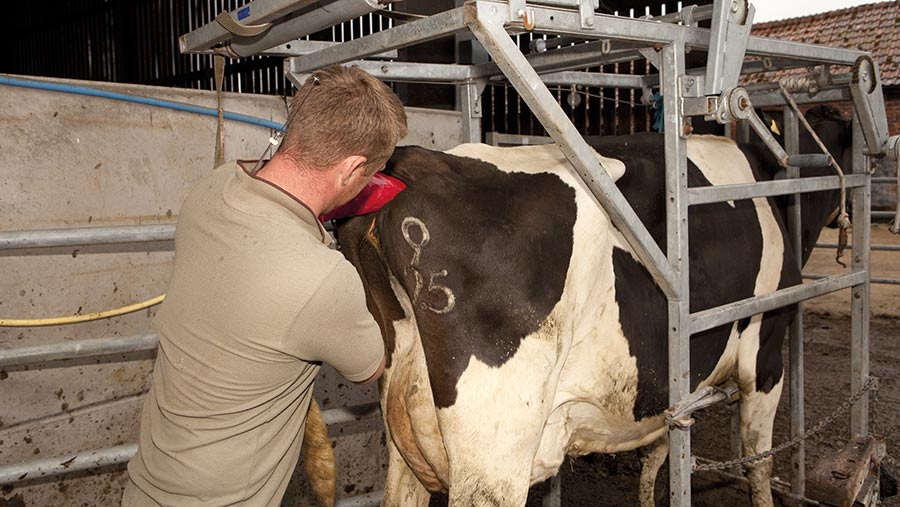Advice on using progesterone devices in dairy cattle
 © Becky Nixon
© Becky Nixon Ensuring cows get back in-calf promptly post-calving is key to optimising profitability in dairy cow enterprises.
Jim McKinstry, veterinary surgeon and a director of Farmgate Vets in Lancashire, gives advice on how progesterone devices can be used to manage cow fertility.
See also: Fertility Focus: What can UK herds learn from US dairy systems?

Jim McKinstry © Jim McKinstry
Common problems which delay service
- Silent heats – when the cow does not show signs of bulling, or does not return to oestrus (bulling)
- High-yielding cows – which have shorter/silent heats because they are putting most of their energy into milk production, and this is often at the expense of getting back in-calf
To meet these demands for milk production, the blood flow through the liver is increased to ensure enough glucose is available.
A side effect of this high liver blood flow is that two key reproductive hormones – oestrogen and progesterone – are broken down more rapidly.
This results in lower circulating levels of both hormones, which can affect fertility as well as the intensity and duration of bulling.
Causes of non-cycling (anoestrus) cows
- Loss of body condition pre-calving
- Cysts
- Uterine infections
- Metabolic disease, such as ketosis or milk fever
How do you manage non-cycling cows?
Synchronisation protocols are the answer – they have a fixed time to serve a cow so she does not have to be seen standing.
These synchronisation protocols have been developed over the past 30 years, and are constantly being improved. The original protocol, Ovsynch, was developed in 1995 and is the basis for many others.
Ovsynch is a combination of gonadotropin-releasing hormone (GnRH) and prostaglandin (PG) injections to give a fixed time to serve a cycling cow. Ovsynch can give a 33% conception rate in a cycling cow.
Progesterone is an important part of this process. Cows that are cycling produce progesterone from the corpus luteum (CL) on their ovary.
Progesterone has many beneficial effects to help get a cow in-calf including:
- Giving feedback to the brain to allow it to release the signal for follicles to ovulate
- Enhancing the quality of the oocytes (eggs) that are released
- Priming the uterus to form glands that nourish the embryo
- Levels before and after service impact conception rates
- Low levels can increase the twinning rate.
How can a progesterone device help?
Using a progesterone device boosts the cycling cow’s levels of this key hormone. It also allows protocols to be used in non-cycling cows that do not have a CL and, therefore, very low levels of progesterone.
Cows that have had a progesterone insert before being served have an embryo that is four times bigger, and release more maternal recognition signals that tell the cow not to come bulling again and maintain the pregnancy.
It has been demonstrated that adding a progesterone insert into a synchronisation protocol can raise the conception rate up to 43%, so the extra investment can really help to get more cows in-calf.
How do I use a progesterone device?
There are two progesterone devices, which differ slightly, licensed for use in the UK.
There are many different protocols available that can be adapted for specific situations, so the number of injections, handlings and time of protocol can all be changed to fit your herd and the animals being synchronised.
Your vet will be able to advise on how, where and when to use protocols with progesterone devices.
